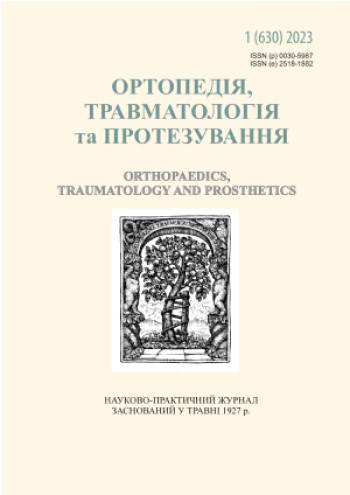CRITERIA FOR PREDICTING RISKS IN THE CASE OF REPLACING AN EXTERNAL FIXATOR WITH AN INTERNAL FIXATOR DURING THE TREATMENT OF GUNSHOT FRACTURES OF THE EXTREMITIES
DOI:
https://doi.org/10.15674/0030-5987202315-9Keywords:
Gunshot fractures, conversion, surgical treatment, scoring scale SF 36, scoring scale for assessing the possibility of conversionAbstract
In the treatment of victims with gunshot fractures of the long bones of the limbs, important importance is attached to determining the need and conditions for performing conversion (replacing the fixation method) with the formulation of reasoned indications. At the first stage of specialized care, such patients are fitted with external fixators, which provides adequate stabilization and simple wound care. Their conversion at the second stage to intraosseous increases the effectiveness of treatment. The aim: To analyze the results of using a scoring scale to substantiate the replacement of the fracture fixation method in the system of treatment of victims with combat limb injuries. Methods. The medical documentation for the period 2014-2021 was studied. The number of patients with gunshot fractures of long bones was 350, the average age was (36.4 ± 1.42) years. Patients were divided into two groups: the main group (193 wounded) — in the preoperative period, the authorʼs scale «Assessment of the possibility of conversion» was used; comparison (157 people) — point assessment was not performed. Methods. Descriptive, comparative analysis, systematic approach, statistical. The SF36 questionnaire was used to assess patients' quality of life. Results. The analysis of treatment results in the long term (1.2‒1.5 years) showed that the use of the author's scale in the preoperative period and the subsequent treatment made it possible to improve the subjective quality of life indicator by an average of 22.2 %. Conclusions. Justification of the expediency of replacing the fixation method during the treatment of patients with gunshot fractures of long bones using the developed scoring scale makes it possible to avoid unjustified conversion, reduce risks and minimize the occurrence of infectious complications.
References
- Donnally, C. J., Lawrie, C. M., Sheu, J. I., Gunder, M. A., & Quinnan, S. M. (2018). Primary intra-medullary nailing of open tibia fractures caused by low-velocity gunshots: Does operative debridement increase infection rates? Surgical Infections, 19(3), 273-277. doi:10.1089/sur.2017.211
- Lerner, A., Jakusonoka, R., Jumtins, A., & Rothem, D. (2023). Temporary bridging trans-hip external fixation in damage control orthopaedics treatment after severe combat trauma: A clinical case series. Injury, 54(3), 991-995. doi:10.1016/j.injury.2023.01.007
- Johnson, D. J., Versteeg, G. H., Middleton, J. A., Cantrell, C. K., & Butler, B. A. (2021). Epidemiology and risk factors for loss to follow-up following operatively treated femur ballistic fractures. Injury, 52(8), 2403-2406. doi:10.1016/j.injury.2021.06.012
- Khomenko, I. P., Korol, S. O., Lurin, I. A., Chelishvili, A. L., & Sichinava, R. M. (2019). Scientific substantiation of the osteosynthesis method conversion in long bones gunshot fractures in the Armed Forces medical system of Ukraine. World of Medicine and Biology, 4 (70), 177-182. doi:10.26724/2079-8334-2019-4-70-177-182 (in Ukrainian)
- Dar , G. N., Tak, S. R., Kangoo, K. A., Dar, F. A., Ahmed, S. T. (2009). External fixation followed by delayed interlocking intramedul¬lary nailing in high velocity gunshot wounds of the femur. Ulusal travma ve acil cerrahi dergisi = Turkish journal of trauma & emergency surgery, 15 (6), 553–558.
- Gustilo, R. B., Mendoza, R. M., & Williams, D. N. (1984). Problems in the management of type III (Severe) open fractures. The Journal of Trauma: Injury, Infection, and Critical Care, 24(8), 742-746. doi:10.1097/00005373-198408000-00009
- Polat, G., Balci, H. İ., Ergin, O. N., Asma, A., Şen, C., & Kiliçoğlu, Ö. (2017). A comparison of external fixation and locked intramedullary nailing in the treatment of femoral diaphysis fractures from gunshot injuries. European Journal of Trauma and Emergency Surgery, 44(3), 451-455. doi:10.1007/s00068-017-0814-6
- Matsumura, T., Takahashi, T., Miyamoto, O., Saito, T., Kimura, A., & Takeshita, K. (2019). Clinical outcome of conversion from external fixation to definitive internal fixation for open fracture of the lower limb. Journal of Orthopaedic Science, 24(5), 888-893. doi:10.1016/j.jos.2019.01.009
- Strafun, S. S., Brusko, A. T., Lyabakh, A. P.( 2007). Diagnosis and treatment of local hypertensive ischemic syndrome (COMPARTMENT SYNDROME). Prevention, diagnosis and treatment of ischemic contractures of the hand and foot. Kyiv : Stilos. (in Ukrainian)
- Pairon, P., Ossendorf, C., Kuhn, S., Hofmann, A., & Rommens, P. M. (2014). Intramedullary nailing after external fixation of the femur and tibia: A review of advantages and limits. European Journal of Trauma and Emergency Surgery, 41(1), 25-38. doi:10.1007/s00068-014-0448-x
Downloads
How to Cite
Issue
Section
License

This work is licensed under a Creative Commons Attribution 4.0 International License.
The authors retain the right of authorship of their manuscript and pass the journal the right of the first publication of this article, which automatically become available from the date of publication under the terms of Creative Commons Attribution License, which allows others to freely distribute the published manuscript with mandatory linking to authors of the original research and the first publication of this one in this journal.
Authors have the right to enter into a separate supplemental agreement on the additional non-exclusive distribution of manuscript in the form in which it was published by the journal (i.e. to put work in electronic storage of an institution or publish as a part of the book) while maintaining the reference to the first publication of the manuscript in this journal.
The editorial policy of the journal allows authors and encourages manuscript accommodation online (i.e. in storage of an institution or on the personal websites) as before submission of the manuscript to the editorial office, and during its editorial processing because it contributes to productive scientific discussion and positively affects the efficiency and dynamics of the published manuscript citation (see The Effect of Open Access).














